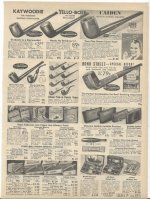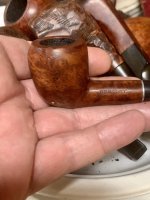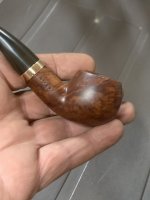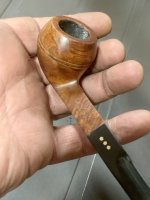Not every business was subject to declines during the Great Depression.
For example, movie tickets provided a temporary escape from the realities of life. So did radios, and much like televisions and later on computers in more modern times they got cheaper and better as the depression dragged on.
A machine made, small pipe during the depression was as cheap as a quarter, made of genuine imported briar. Some brands of pipe tobacco were as cheap as a dime for two ounces.
Most decent pipes seem to have been retailed at fifty cents, For about $11 in our money the customer got a small chambered (to get 50 smokes from a can of tobacco) screw stem pipe with a condenser. It was stained and varnished, with a moulded stem not entirely hard rubber, some kind of modern nylon or plastic. Missouri Meerschaum uses those stems today on cheaper pipes.
By the end of the decade and right before the war there were about thirty million briar pipes a year sold in the United States, and KB&B claimed 11 million of those.
The top pipe of the Depression was the $25 Marxman freehand “400” and Marx also sold a lot of $5, $7.50, and $10 pipes.
What the extra money bought were the tightest grained, best smoking pipes ever made in America, from well cured and aged Algerian briar.
And at Kaywoodie, more money bought the most beautiful grained and figured pipes ever made here, from the $3.50 Drinkless, $5 Supergrain, and in 1937 a magnificently grained $10 Flame Grain.
The war cut off all supplies of imported briar for the duration.
After the war the pipes aren’t as beautiful, but a Marxman kept up quality to the end of production in 1953.
Lee made beautiful, tightly grained pipes beginning in 1946 until sometime in the fifties the fit and finish started to slide, stamped stars replacing gold inlaid stars, and finally a Lee was a push stemmed drugstore pipe.
Kaywoodie pipes also slipped down in quality until in 1972 they became varnished drugstore pipes.
But I am convinced that any high grade pipe from the golden era, especially the late thirties and also the late forties, that cost $3.50 and up then are the best bargains in used pipes.
Our grandparents were not dumb.
When they paid seven to twenty times more than a decent drugstore grade pipe they got their money’s worth.
Here’s page from the 1939 Sears catalog for pricing information.

For example, movie tickets provided a temporary escape from the realities of life. So did radios, and much like televisions and later on computers in more modern times they got cheaper and better as the depression dragged on.
A machine made, small pipe during the depression was as cheap as a quarter, made of genuine imported briar. Some brands of pipe tobacco were as cheap as a dime for two ounces.
Most decent pipes seem to have been retailed at fifty cents, For about $11 in our money the customer got a small chambered (to get 50 smokes from a can of tobacco) screw stem pipe with a condenser. It was stained and varnished, with a moulded stem not entirely hard rubber, some kind of modern nylon or plastic. Missouri Meerschaum uses those stems today on cheaper pipes.
By the end of the decade and right before the war there were about thirty million briar pipes a year sold in the United States, and KB&B claimed 11 million of those.
The top pipe of the Depression was the $25 Marxman freehand “400” and Marx also sold a lot of $5, $7.50, and $10 pipes.
What the extra money bought were the tightest grained, best smoking pipes ever made in America, from well cured and aged Algerian briar.
And at Kaywoodie, more money bought the most beautiful grained and figured pipes ever made here, from the $3.50 Drinkless, $5 Supergrain, and in 1937 a magnificently grained $10 Flame Grain.
The war cut off all supplies of imported briar for the duration.
After the war the pipes aren’t as beautiful, but a Marxman kept up quality to the end of production in 1953.
Lee made beautiful, tightly grained pipes beginning in 1946 until sometime in the fifties the fit and finish started to slide, stamped stars replacing gold inlaid stars, and finally a Lee was a push stemmed drugstore pipe.
Kaywoodie pipes also slipped down in quality until in 1972 they became varnished drugstore pipes.
But I am convinced that any high grade pipe from the golden era, especially the late thirties and also the late forties, that cost $3.50 and up then are the best bargains in used pipes.
Our grandparents were not dumb.
When they paid seven to twenty times more than a decent drugstore grade pipe they got their money’s worth.
Here’s page from the 1939 Sears catalog for pricing information.











